
An abbey is a type of monastery used by members of a religious order under the governance of an abbot or abbess. Abbeys provide a complex of buildings and land for religious activities, work, and housing of Christian monks and nuns.

Abano Terme is a town and comune in the Province of Padua, in the Veneto region, Italy, on the eastern slope of the Euganean Hills; it is 10 kilometres (6 mi) southwest by rail from Padua. Abano Terme's population is 19,062 (2001).

Altenburg Abbey is a Benedictine monastery in Altenburg, Lower Austria. It is situated about 30 kilometres (19 mi) to the north of Krems an der Donau in the Waldviertel. It was founded in 1144,by Countess Hildeburg of Poigen-Rebgau. Throughout its history it suffered numerous invasions and attacks, and was destroyed by the Swedes in 1645. Under Emperor Joseph II in 1793 the abbey was forbidden to accept new novices, but unlike many others in Austria it succeeded in remaining functional.

Wilhering Abbey is a Cistercian monastery in Wilhering in Upper Austria, about 8 km (5 mi) from Linz. It was founded in 1146. The buildings, re-constructed in the 18th century, are known for their spectacular Rococo decoration.

Galzignano Terme is a comune (municipality) in the Province of Padua in the Italian region Veneto, located about 50 kilometres (31 mi) southwest of Venice and about 15 kilometres (9 mi) southwest of Padua.
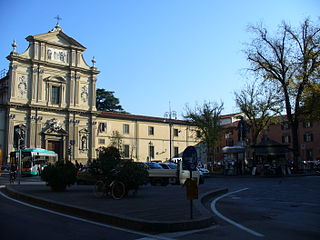
Museo Nazionale di San Marco is an art museum housed in the monumental section of the medieval Dominican convent of San Marco dedicated to St Mark, situated on the present-day Piazza San Marco, in Florence, a region of Tuscany, Italy.

The Kaisariani Monastery is an Eastern Orthodox monastery built on the north side of Mount Hymettus, near Athens, Greece.
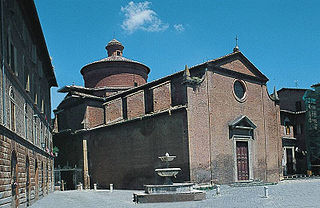
Santo Spirito is a Renaissance style, Roman Catholic church located in piazza Santo Spirito, where Via dei Pispini meets Vicolo del Sasso, in Siena, Italy.

The Abbey of Monte Oliveto Maggiore is a large Benedictine monastery in the Italian region of Tuscany, 10 km south of Asciano. Its buildings, which are mostly of red brick, are conspicuous against the grey clayey and sandy soil—the Crete senesi which give this area of Tuscany its name.

The Abbey of Santa Maria di Rovegnano is a Cistercian monastic complex in the comune of Milan, Lombardy, northern Italy. The borgo that has developed round the abbey was once an independent commune called Chiaravalle Milanese, now included in Milan and referred to as the Chiaravalle district.

Johann Jakob Zeiller was an Austrian painter.

The Abbey of San Benedetto in Polirone is a large complex of Benedictine order monastic buildings, including a church and cloisters, located in the town of San Benedetto Po, Province of Mantua, Region of Lombardy, Italy. The complex, now belonging to the city, houses offices, a museum, and is open to visitors.

San Giovanni Evangelista is a Mannerist-style, Roman Catholic church located on Piazzale San Giovanni, located just behind the apse of the Parma Cathedral, in the historic center of Parma, northern Italy. The buildings surrounding the piazza were also part of a former Benedictine convent. The church is notable for its Correggio frescoes.

The Abbey of Santa Giustina is a 10th-century Benedictine abbey complex located in front of the Prato della Valle in central Padua, region of Veneto, Italy. Adjacent to the former monastery is the basilica church of Santa Giustina, initially built in the 6th century, but whose present form derives from a 17th-century reconstruction.

Sázava Monastery is a former Benedictine abbey and a monastery in Bohemia, established by Bretislaus I, Duke of Bohemia around 1032. It is situated some 30 km southeast of Prague, on the right bank of the eponymous Sázava river, a right tributary of the Vltava. The town of Sázava grew around the monastery.
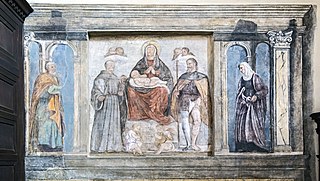
Girolamo Tessari, also called Gerolamo Tessari or Girolamo dal Santo, was an Italian painter, active in a Renaissance style in his native city of Padua.
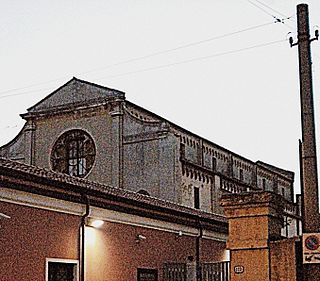
San Giovanni di Verdara or Saint John of Verdara is a former Roman Catholic monastery and church located on Via San Giovanni di Verdara # 123, in the city of Padua, region of Veneto, Italy. It was founded in 1221, but now serves as a military hospital, and is not accessible to the public.
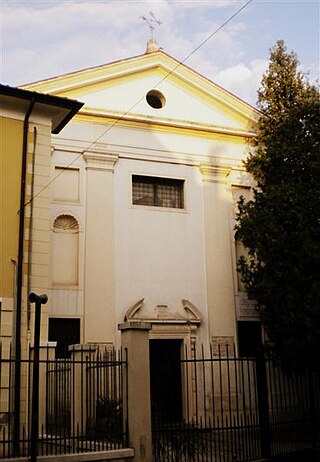
Santa Caterina d'Alessandria is a small, Baroque-style, Roman Catholic church and convent located on via Cesare Battisti #245 in the city of Padua in the region of Veneto, Italy.
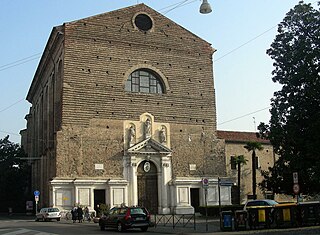
The Basilica del Carmine is a 16th-century Roman Catholic church located on piazza Francesco Petrarca in Padua, region of Veneto, Italy. It was made a minor basilica in 1960 by pope John XXIII

San Daniele is a Roman Catholic church and monastery in Padua, region of Veneto, Italy.






















